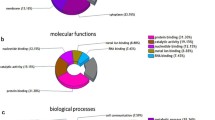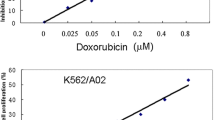Abstract
Aims
Proteomic study was used to explore new multidrug resistance (MDR)-related proteins and clarify novel mechanism of MDR in gastric cancer.
Methods
Two-dimensional gel electrophoresis and the PDQuest software analysis were applied to compare the differential expression of MDR-related proteins in gastric cancer SGC7901 cells and drug-resistant SGC7901 cells (SGC7901/VCR) induced by vincristine sulfate (VCR). The differential protein dots were excised and further analyzed by matrix-assisted laser desorption ionization-time of flight mass spectrometry analysis (MALDI-TOF-MS).
Results
Nine differential expression proteins between the two cell lines were successfully identified by MALDI-TOF-MS. Triosephosphate isomerase (TPI), a glycolytic pathway enzyme, was identified as a downregulated protein in SGC7901/VCR cells. Further, Western blot analysis and semiquantitative RT-PCR confirmed its decreased expression in SGC7901/VCR cells. Sense vector pcDNA3.1-TPI was constructed and transfected into SGC7901/VCR. The sensitivity of TPI-SGC7901/VCR cells to adriamycin (ADR), VCR, 5-fluorouracil and cis-dichlorodiamine platinum, as well as the accumulation and retention to ADR, were significantly increased when compared to their control cell lines.
Conclusions
These results provide new MDR-related protein candidates, which are differentially expressed in the MDR cell line and its parental cell line including TPI, which may participate in the VCR-mediated MDR in human gastric cancer. Upregulation of TPI expression could partially reverse multidrug-resistant phenotype of SGC7901/VCR, which suggests that TPI may be an anti-drug resistance agent in gastric cancer and the candidate target to develop novel therapeutics for better treatment of gastric cancer.





Similar content being viewed by others
Abbreviations
- MDR:
-
Multidrug resistance
- GST:
-
Glutathione S-transferase
- LRP:
-
Lung resistance protein
- MRP:
-
Multidrug resistance-associated protein
- PBS:
-
Phosphate-buffered saline
- P-gp:
-
P-glycoprotein
- RP:
-
Ribosomal protein
- SDS:
-
Sodium dodecyl sulfate
- MALDI-TOF-MS:
-
Matrix-assisted laser desorption ionization-time of flight-mass spectrometry
- PMF:
-
Peptide mass fingerprint
- TPI:
-
Triosephosphate isomerase
- VCR:
-
Vincristine
- ADR:
-
Adriamycin
- 5-Fu:
-
5-Fluorouracil
- MMC:
-
Mitomycin C
- CCDP:
-
cis-Dichlorodiamine platinum
References
An HZ, Zhou SJ, Fan DM (1997) Establishment and characteristics of an adriamycin resistant human gastric carcinoma cell line. Xiandai Xiaohua Bing Ji Neijing Zazhi 2:108–110
Ationu A, Humphries A, Bellingham A, Layton M (1997) Metabolic correction of triose phosphate isomerase deficiency in vitro by complementation. Biochem Biophys Res Commun 232:528–531
Berois N, Blanc E, Ripoche H (2006) ppGalNAc-T13: a new molecular marker of bone marrow involvement in neuroblastoma. Clin Chem 52:1701–1712
Butt YK, Lum JH, Lo SC (2003) Proteomic identification of plant proteins probed by mammalian nitric oxide synthase antibodies. Planta 216:762–771
Cai XJ, Zhang XY, Fan DM (1994) Establishment of multidrug resistant gastric cancer cell line and its biological characteristics. Zhongguo Zhongliu Linchuang 2:67–71
Dabrowski MJ, Maeda D, Zebala J (2006) Glutathione S-transferase P1-1 expression modulates sensitivity of human kidney 293 cells to photodynamic therapy with hypericin. Arch Biochem Biophys 449:94–103
Dean M, Fojo T, Bates S (2005) Tumor stem cells and drug resistance. Nat Rev Cancer 5:275–284
Dimitroulakos J, Marhin WH, Tokunaga J (2002) Microarray and biochemical analysis of lovastatin-induced apoptosis of squamous cell carcinomas. Neoplasia 4:337–346
Ettinger SL, Sobel R, Whitmore TG (2004) Dysregulation of sterol response element-binding proteins and downstream effectors in prostate cancer during progression to androgen independence. Cancer Res 64:2212–2221
Fan K, Fan D, Cheng L, Li C (2000) Expression of multidrug resistance related markers in gastric cancer. Anticancer Res 20:4809–4814
Fan D, Zhang X, Chen X, Mou Z, Hu J, Zhou S, Ding J, Wu K (2005) Bird’s-eye view on gastric cancer research of the past 25 years. J Gastroenterol Hepatol 20:360–365
Freire T, Berois N, Sonora C et al (2006) UDP-N-acetyl-d-galactosamine:polypeptide N-acetylgalactosaminyltransferase 6 (ppGalNAc-T6) mRNA as a potential new marker for detection of bone marrow-disseminated breast cancer cells. Int J Cancer 119:1383–1388
Hirokawa Y, Arnold M, Nakajima H (2005) Signal therapy of breast cancers by the HDAC inhibitor FK228 that blocks the activation of PAK1 and abrogates the tamoxifen-resistance. Cancer Biol Ther 4:956–960
Inoue S, Salah-Eldin AE, Omoteyama K (2001) Apoptosis and anticancer drug resistance. Hum Cell 14:211–221
Johnstone RW, Ruefli AA, Lowe SW (2002) Apoptosis: a link between cancer genetics and chemotherapy. Cell 108:153–164
Kovarova H, Hajduch M, Korinkova G, Halada P, Krupickova S, Gouldsworthy A, Zhelev N, Strnad M (2000) Proteomics approach in classifying the biochemical basis of the anticancer activity of the new olomoucine-derived synthetic cyclin-dependent kinase inhibitor, bohemine. Electrophoresis 21:3757–3764
Lee BC, Cha K, Avraham S (2004) Microarray analysis of differentially expressed genes associated with human ovarian cancer. Int J Oncol 24:847–851
Liu Y, Liu H, Han B, Zhang JT (2006) Identification of 14-3-3sigma as a contributor to drug resistance in human breast cancer cells using functional proteomic analysis. Cancer Res 15:3248–3255
Nakahara H, Otani T, Sasaki T (2003) Involvement of Cdc42 and Rac small G proteins in invadopodia formation of RPMI7951 cells. Genes Cells 8:1019–1027
Park DJ, Lenz HJ (2006) Determinants of chemosensitivity in gastric cancer. Curr Opin Pharmacol 6:337–344
Roesch-Ely M, Nees M, Karsai S (2007) Proteomic analysis reveals successive aberrations in protein expression from healthy mucosa to invasive head and neck cancer. Oncogene 26:54–64
Salinas AE, Wong MG (1999) Glutathione S-transferases—a review. Curr Med Chem 531:6279–6309
Shi Y, Zhai H, Wang X, Han Z, Liu C, Lan M et al (2004) Ribosomal proteins S13 and L23 promote multidrug resistance in gastric cancer cells by suppressing drug-induced apoptosis. Exp Cell Res 296:337–346
Siddik ZH (2003) Cisplatin: mode of cytotoxic action and molecular basis of resistance. Oncogene 22:7265–7279
Stavrovskaya AA (2000) Cellular mechanism of multidrug resistance to tumor cells. Biochemistry (Mosc) 65:112–116
Svasti J, Srisomsap C, Subhasitanont P (2005) Proteomic profiling of cholangiocarcinoma cell line treated with pomiferin from Derris malaccensis. Proteomics 5:4504–4509
Wang X, Lan M, Shi YQ, Lu J, Zhong YX, Wu HP et al (2002) Differential display of vincristine-resistance-related genes in gastric cancer SGC7901 cells. World J Gastroenterol 8:54–59
Zhang D, Tai LK, Wong LL (2005) Proteomic study reveals that proteins involved in metabolic and detoxification pathways are highly expressed in HER-2/neu-positive breast cancer. Mol Cell Proteomics 4:1686–1696
Zhao Y, You H, Liu F, An H, Shi Y, Yu Q et al (2002) Differentially expressed gene profiles between multidrug resistant gastric adenocarcinoma cells and their parental cells. Cancer Lett 185:211–218
van den Bemd GJ, Krijgsveld J, Luider TM (2006) Mass spectrometric identification of human prostate cancer-derived proteins in serum of xenograft-bearing mice. Mol Cell Proteomics 5:1830–1839
Acknowledgments
This work was supported by grants from National Natural Science Foundation of China (No. 30672399 and No. 30371762).
Author information
Authors and Affiliations
Corresponding author
Additional information
Xin Wang and Yuanyuan Lu contributed equally to this work.
Rights and permissions
About this article
Cite this article
Wang, X., Lu, Y., Yang, J. et al. Identification of triosephosphate isomerase as an anti-drug resistance agent in human gastric cancer cells using functional proteomic analysis. J Cancer Res Clin Oncol 134, 995–1003 (2008). https://doi.org/10.1007/s00432-008-0367-5
Received:
Accepted:
Published:
Issue Date:
DOI: https://doi.org/10.1007/s00432-008-0367-5




